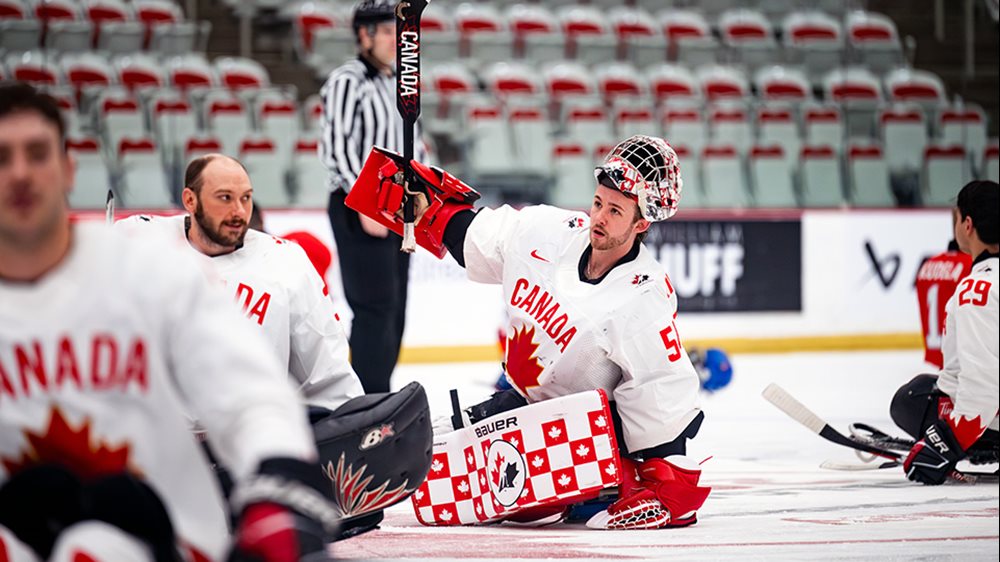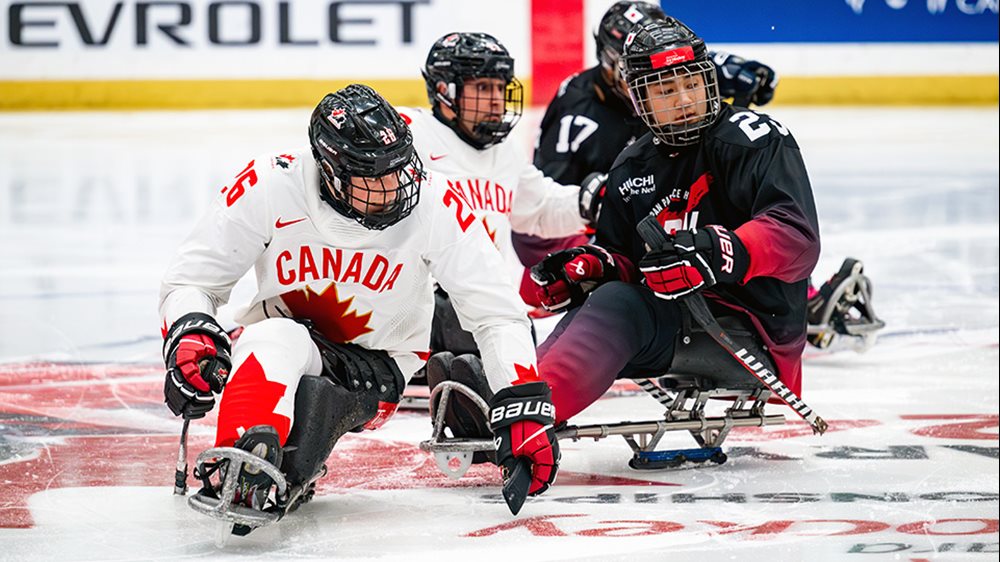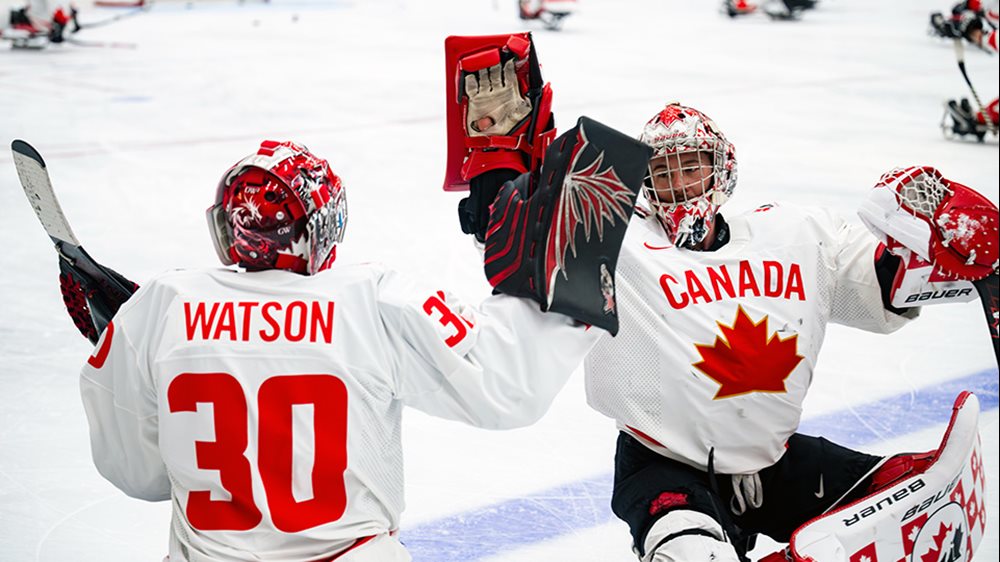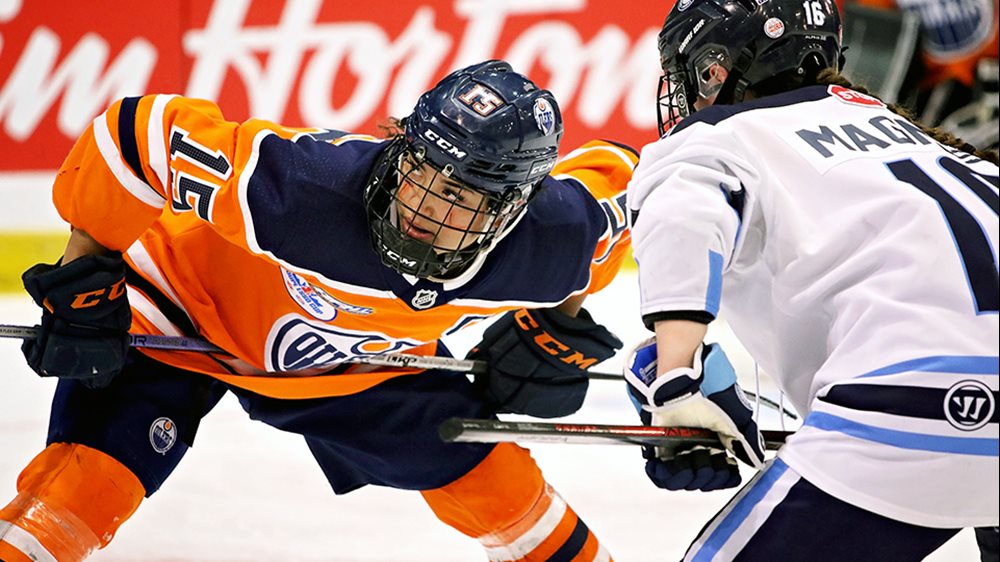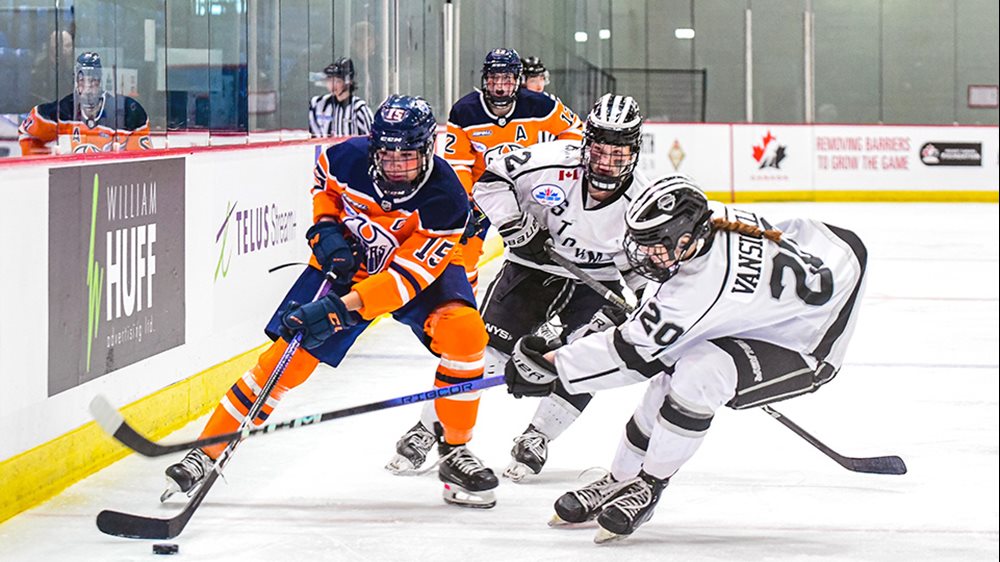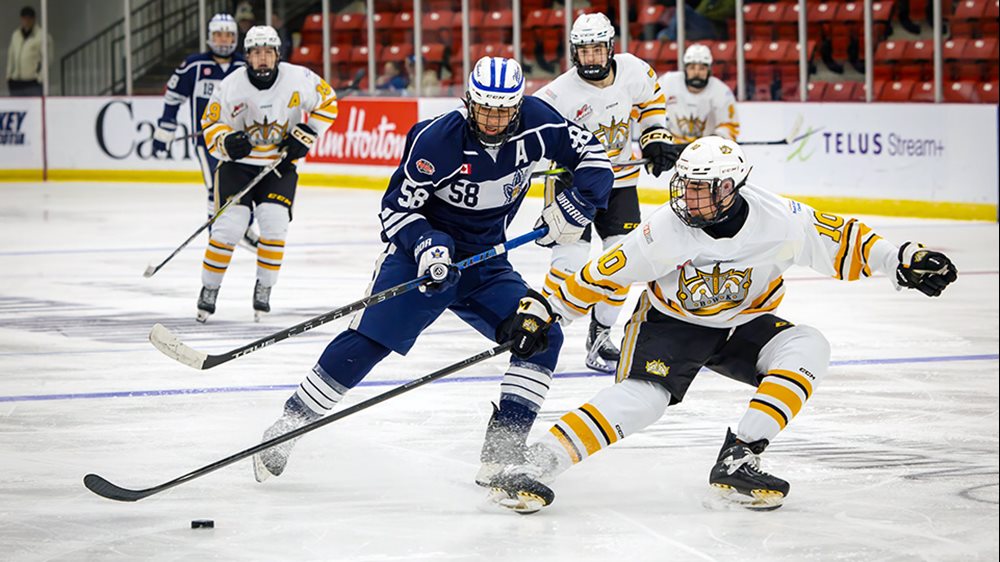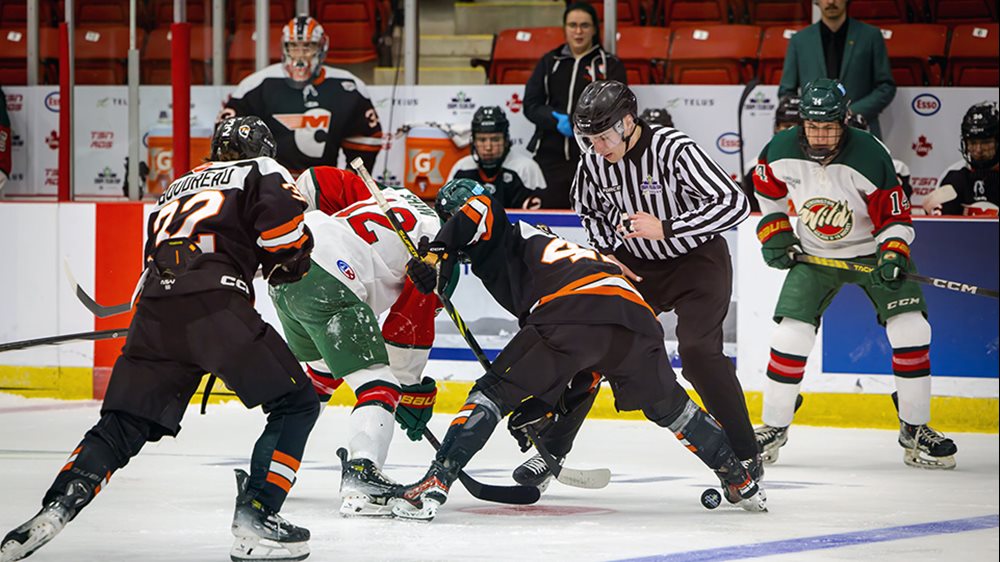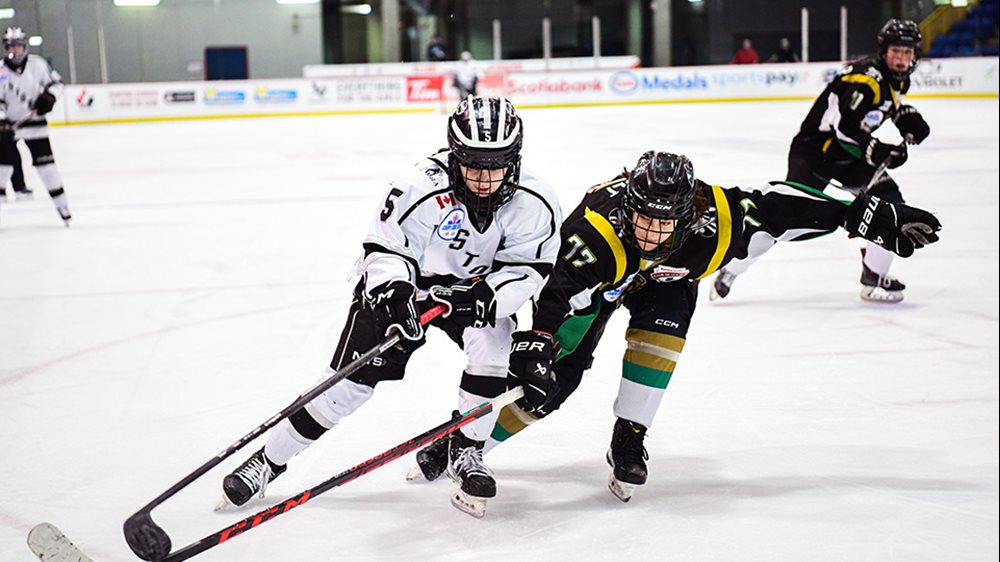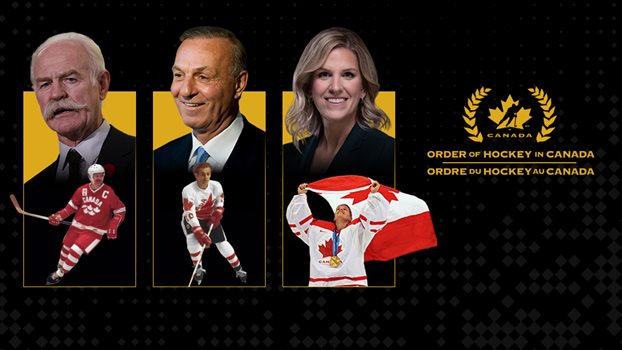
Class of 2022 unveiled for Order of Hockey in Canada
Lafleur, McDonald and St-Pierre to be honoured at Hockey Canada Foundation Gala & Golf in Niagara Falls
NIAGARA FALLS, Ont. – Hockey Canada has announced that Guy Lafleur (Thurso, Que.), Lanny McDonald (Hanna, Alta.) and Kim St-Pierre (Châteauguay, Que.) have been named to the Order of Hockey in Canada as Distinguished Honourees for 2022. The trio will be recognized for their outstanding contributions to the sport at the annual Hockey Canada Foundation Gala & Golf in Niagara Falls, Ont., this June.
The Order is a Hockey Canada initiative to celebrate individuals for their outstanding contributions or service to the growth and development of the sport of hockey in Canada. A total of 36 men and women have now been named to the Order of Hockey in Canada since it was first introduced in 2012.
Guy Lafleur – Voted one of the 100 Greatest NHL Players during the league’s centennial season in 2016-17, Lafleur had a storied 17-year career with the Montreal Canadiens, New York Rangers and Quebec Nordiques. A 1988 inductee into the Hockey Hall of Fame, Lafleur was named to the NHL First All-Star Team six times and is the all-time leading scorer in Montreal Canadiens history with 1,276 points. He is a five-time Stanley Cup champion, and won the Art Ross Trophy three times, the Lester B. Pearson Award three times, the Hart Memorial Trophy twice and the Conn Smythe Trophy in 1977. In addition to his success in the NHL, Lafleur recorded 18 points (four goals, 14 assists) in 21 games with Team Canada and won the 1976 Canada Cup. Lafleur was invested as an Officer of the Order of Canada in 1980 and had his No. 10 retired by the Canadiens in 1985.
Lanny McDonald – A four-time NHL all-star, McDonald co-captained the Calgary Flames to the franchise’s first Stanley Cup in 1989. Over a 16-year NHL career with the Flames, Toronto Maple Leafs and Colorado Rockies, McDonald won the Bill Masterson Memorial Trophy, the King Clancy Memorial Trophy and recorded 1,006 points in 1,111 games. His No. 9 was retired by the Flames in 1990 and he was inducted into the Hockey Hall of Fame in 1992. He wore the Maple Leaf twice, including at the 1976 Canada Cup, where he earned an assist on Darryl Sittler’s double-overtime winner that gave Team Canada the championship. As an executive, McDonald has represented Team Canada as general manager and director of player personnel, winning a gold medal as director of player personnel at the 2004 IIHF World Championship.
Kim St-Pierre – Inducted into the Hockey Hall of Fame in 2021, St-Pierre ranks first among goaltenders in games played (83), wins (64) and shutouts (29) in National Women’s Team history. St-Pierre won three Olympic gold medals, five IIHF Women’s World Championship gold medals and two Clarkson Cups during her storied career, and was named Top Goaltender at the 2002 Olympic Winter Games. She was named CWHL Goaltender of the Year three times and was twice named to the CWHL First All-Star Team. St-Pierre attended McGill University, where she was a three-time All-Canadian, was recognized as the top Canadian university women’s athlete of the year and became the first woman to win a Canadian men’s university hockey game in 2003.
"To be named to the Order of Hockey in Canada is one of the most prestigious accomplishments in our sport and all three Distinguished Honourees in the Class of 2022 are incredibly deserving of this honour,” said Tom Renney, chief executive officer of Hockey Canada. “Guy, Lanny and Kim have each contributed immensely to the growth of hockey across our country and internationally and we are thrilled that they will be celebrated in Niagara Falls this June.
On behalf of Hockey Canada, our board and the Order of Hockey in Canada selection committee, I would like to congratulate Guy, Lanny and Kim on this tremendous achievement.”
Appointed by the Order of Hockey in Canada executive committee, established by Hockey Canada, the 12-member selection committee is tasked with nominating and selecting the annual recipients of the Order of Hockey in Canada via secret ballot.
For a full list of the 36 Distinguished Honourees of the Order of Hockey in Canada, please visit HockeyCanada.ca/OOHIC.
2022 Hockey Canada Foundation Gala & Golf to be held in Niagara Falls
The 2022 Distinguished Honourees of the Order of Hockey in Canada will be recognized at the annual Hockey Canada Foundation Gala & Golf, June 23-24 in Niagara Falls.
Originally scheduled to be hosted in Niagara Falls in June 2020, the event will also celebrate the six Distinguished Honourees named to the Order of Hockey in Canada in 2020 and 2021: Ken Dryden, Bill Hay, Angela James, Sheldon Kennedy, Kevin Lowe and Dr. Charles Tator.
The Hockey Canada Foundation Gala & Golf, which leaves 50 per cent of its net proceeds within the host community and surrounding region, has raised over $7.5 million since 2009.
For more information on the Hockey Canada Foundation and Order of Hockey in Canada, please visit HockeyCanada.ca.

My father, my friend
Few have matched what Guy Lafleur accomplished on the ice, but for his son, his lasting legacy isn’t as a Montreal Canadiens legend – it’s simply as ‘Dad’
The view of life through a child’s eyes often conjures a unique perspective. It’s usually an untainted lens of innocence and fondness with a charming projection.
For Martin Lafleur, that sentiment is not only an adolescent image of his father growing up but a realistic picture of the journey they shared together for over four decades.
As the oldest of the two sons of Montreal Canadiens great Guy Lafleur, Martin was more than just a son to his father; they were business partners, teammates and – most of all – great friends.
Lafleur’s admiration for his dad was absolute. It wasn’t just about having a famous hockey-playing father, but also appreciating the family man he was to his mother, Lise, and younger brother Mark.
“The hockey player is something that’s been part of our family, our lives,” says Martin, 47. “But it’s more of the human part that’s always been pretty remarkable to observe about my dad.”
Guy Lafleur spent 17 seasons in the National Hockey League, most notably with the Canadiens, but also with the New York Rangers and Quebec Nordiques, from 1971 to 1991.
He won five Stanley Cups with the Habs (1973, 1976, 1977, 1978 and 1979) and was the first player in NHL history to score 50 goals in six consecutive seasons, as well as 50 goals and 100 points six years in a row.
On the ice, Lafleur was special. He was a superstar among a constellation of hockey icons the Canadiens produced in abundance during that era.
He especially electrified fans at the Montreal Forum for 14 seasons with his blazing speed and exquisite shot and terrified the opposition with his tremendous skating, offensive skill and elusiveness.
Over his career, the Thurso, Que., product was named a first-team all-star six times and was awarded the Art Ross Trophy (3x), Hart Trophy (2x), Lester B. Pearson Award (now Ted Lindsay Award) (3x) and Conn Smythe Trophy. He was inducted into the Hockey Hall of Fame in 1988 and was voted as one of the 100 Greatest NHL Players in 2017.
It is not hyperbole to suggest Lafleur was beloved by countless hockey fans globally and even highly respected by those that cheered against his teams.
But to Martin Lafleur, his father was not just defined as a hockey player. Sure, the game made him famous, but his personal impact to everyone around him was broader than a singular definition of character.
Away from the rink, Lafleur was charitable and philanthropic, often visiting youngsters at children’s hospitals and donating thousands of dollars to the Montreal Canadiens Children’s Foundation.
In retirement he was still as popular as ever, especially in Quebec, where he was revered. According to Martin, his dad was often approached by fans to pose for pictures and selfies, and asked for autographs – which he never refused.
“He’s a people person,” says Martin, who owns and operates a company called Dello, a Montreal-based cryptocurrency payment processing business.
“Even though he’s had a lot of success in his hockey career and been at the top of his game, he’s always been that down-to-earth guy and somebody when you talk to him, you have his full attention.”
Lafleur was so popular and charismatic as an athlete and in life that he was bestowed not one, but two, nicknames over his career.
The first, “The Flower” is a direct English translation from his French last name, but also metaphorically illustrated his radiant presence on the ice and in life.
The other was “Le Demon Blond,” which Martin says doesn’t translate very well in English, but loosely evokes the image many of us remember of Guy Lafleur skating at lightning speed down the right-wing boards with his helmetless blonde hair flowing in the breeze.
Both nicknames were used often but segregated for the crowd in which he was present – The Flower mostly amongst close friends and teammates and Le Demon Blond – which Martin admits is his favourite – by fans.
Born in 1975 at the height of his father’s storied career and now a husband and father himself, Martin said he always tangibly understood what his dad meant to hockey, the Canadiens and his fans, but never truly felt the depth of what he portrayed until the public memorial service to honour his dad’s passing at the Bell Centre this spring.
Guy Lafleur died April 22 at the age of 70.
“I saw people were sad,” Martin Lafleur admits. “That’s when I realized the impact he had on the human side and how he touched people.
“People weren’t telling me hockey stories. They were sharing life stories. That’s what really amazed me. Unfortunately, I had to fully grasp that through the scenario of my dad’s passing.”
One story that resonated strongly in this regard was from another father that shared his admiration of the former first-overall pick of the Canadiens in 1971.
Martin said the man was inspired by his dad for the way Guy handled and supported his youngest son, Mark, who over a 10-year period ran afoul with the law on more than one occasion.
Again, the family-first person that he was, Lafleur stood behind his son through the legal strife and proceedings, even challenging some of the legalities in court himself.
At Lafleur’s celebration of life service, Martin delivered part of the eulogy to his father. It was an emotional, heartfelt and concise description of his dad’s impact on the world.
Moreover, that articulate expression will likely serve as a precursor to Martin accepting the Order of Hockey in Canada on his father’s behalf this month.
As one of three Distinguished Honourees for 2022, Lafleur will be recognized for his outstanding contributions to the sport at the annual Hockey Canada Foundation Gala & Golf in Niagara Falls, Ont.
And while the honour will be presented posthumously, Lafleur was informed of the prestigious distinction prior to his death, an accolade Martin says his father was deeply touched and privileged to receive.
“We value our province and our country,” says Martin. “It’s such a great honour for our family. We’re more than appreciative to get this acknowledgement on his behalf.”
The Order of Hockey in Canada and the lead-up to its formal presentation will undoubtedly stir many memories for the Lafleur family, especially Martin.
From the time he was born amid the Canadiens’ incredible run of four straight Stanley Cups between 1976 and 1979 to the conclusion of his dad’s career in 1991, he spent many hours around hockey rinks, including the Montreal Forum, New York’s Madison Square Garden and Quebec City’s Le Colisée – the three NHL stops in Guy’s career.
Of course, those years were all tied to his dad’s hockey career, but Martin was brought to the rink on many occasions, hanging out with other Canadiens players and their kids, and skating with them before or after practice. He attended team golf tournaments and eventually played with the Habs alumni team.
Those interactions from an early age helped off-set some of the time he missed with his dad as travel in the NHL often prevents consistent home time during the season.
“There were a lot of years in my youth that I saw him more on TV than I did in real life,” says Martin. “It was his after-career that allowed me to really spend time with him. I had fabulous moments as a child, but I had a lot more of them after he retired. That was very important to me.”
Hockey was meaningful to Guy Lafleur and his family, but it wasn’t imperative to him that his boys followed the same path. Sure, Martin played the game growing up and still does, although he admits his drive and passion for other sports like snowboarding and soccer internally created more drive and passion.
“Sports were always a huge part of my life, but hockey was just one of them,” Martin says. “My dad never really pushed us. Whatever we decided to do he just wanted us to enjoy it.”
He says Guy was never much on providing pointers during his minor hockey days and jovially mentions his dad “was awful as a hockey coach.”
However, by the time the two were able to play together during Montreal Canadiens alumni events, Martin says skating with his father as a teammate was a great experience, although the senior Lafleur was also “very capable” of telling you if you did something wrong.
When his hockey career concluded and right up until his final day, Guy Lafleur was a busy guy.
He and Martin were involved in business together, including several restaurants, while they both attended many events like sports card and memorabilia shows, where for close to the last decade Martin acted as his father’s de facto agent, organizing travel and attending those work/play events together.
“We’ve had a really close relationship. I’m so grateful to have spent that quality time with him.”
Lafleur was also very patriotic. He was an honorary colonel in the Canadian Air Force, making several trips to support Canadian Forces in places like Kuwait, Afghanistan and Ukraine. He was proud to represent his country at the Canada Cup in 1976 and 1981, and again at the 1981 IIHF World Championship.
And among the other notable honours and awards bestowed on him, Lafleur was also made an Officer of the Order of Canada and a Knight of the National Order of Quebec.
“Both were huge honours,” says Martin. “My dad was French-Canadian, but he was so proud to be Canadian.”
To Martin, his dad’s legacy stands alone, but he’ll try to conduct himself appropriately and use it as a template for his future.
“Those shoes are unfillable,” he says. “But I definitely want to do as much as I can to continue what my dad did in my own way. That’s the way we were brought up. We still owe everything to my dad’s fans. With pleasure, that’s something that will continue.”

When opportunity knocks
Kim St-Pierre once nearly quit hockey – but when one door opened, the goaltender found a home not only in the women’s game, but in the Hockey Hall of Fame
Kim St-Pierre remembers sitting on the couch in her home in Châteauguay, Quebec. It’s February 1998, the middle of the night, and her mom wants her to watch a hockey game being played halfway around world in Nagano, Japan. Canada’s National Women’s Team is playing the United States for the first Olympic gold medal in women’s hockey.
“I don’t know why,” says St-Pierre, “but I had this vision, this feeling, that one day – I didn’t know how because I was so far from it – that I could wear that jersey. I would have loved for them to win that gold medal, but that’s the moment when I looked at my mom and wished that one day I could wear this special jersey.”
St-Pierre would wear that jersey 83 times for Team Canada from 1998 to 2011. She won three gold medals at the Olympic Winter Games and five gold medals at the IIHF World Women’s Championship (as well as four silver medals). She posted a 64-10 record, with a 1.17 goals-against average, a .939 save percentage and 29 shutouts. She ranks No. 1 among Canadian goaltenders in games played, wins and shutouts.
In 2021, she became the first female goaltender – and eighth woman – inducted into the Hockey Hall of Fame.
St-Pierre’s journey to her historic destination began like so many Canadian players: street hockey in the summer, a backyard rink in the winter and older siblings directing the youngest to stand in net.
“I fell in love with the sport,” she says. She asked her parents to play on an organized team. “At first it was not easy for them – they weren’t seeing any Team Canada, it was not an Olympic sport, and nothing really to be excited to put your daughter in. But they loved how passionate I was.”
Her dad, André, had played hockey at a high level and been drafted by the New York Rangers. His familiarity with the hockey environment eased everyone’s mind, when, at age eight, St-Pierre transitioned from figure skating to hockey.
St-Pierre started as a forward. One day her coach walked into the room with goalie gear. Inexplicitly drawn to the unattractive old, brown equipment, St-Pierre jumped up to volunteer. Her mom, Louise, may have thought her daughter was crazy, but she encouragingly helped her dress that day.
One practice turned into one game. That one game was unremarkable, and St-Pierre knows her parents could have easily suggested she stick to be being skater. “But they saw how disappointed I was,” she says. “I think it was a great life lesson to just keep going, to work harder to be able to win my first game as a goalie. We never looked back. I’m thankful that they helped me, guided me. I become a goalie.”
St-Pierre idolized Patrick Roy and dreamed of playing for the Montreal Canadiens. A multisport athlete – including tennis, soccer and fastball – she wanted to go to the Olympic Games in anything except hockey, the one sport where she couldn’t see women competing at the time. Those two goals drove her through her teens playing boys’ hockey.
“It was about having a passion for sport,” she says. “It never really mattered that I was the only girl. Being a goalie you’re different, you’re special, you have different equipment. For me, it was a way to stand out and to play because I loved it, not because I wanted to be the first one to accomplish something.”
St-Pierre’s days of playing organized hockey appeared to be coming to a close in 1998. She had finished her junior career and could never crack the roster to represent Team Quebec at various national women’s championships. “I was almost ready to quit, not seeing any opportunities for me.”
Around that time, Dan Madden, the general manager of the women’s team at McGill University in Montreal, offered her the chance to try out for the Martlets. Having been repeatedly released from Team Quebec, St-Pierre didn’t have the warmest memories playing women’s hockey. But a talk with her dad and a visit to the team convinced her that this was where she should be. “It’s a decision that changed my life,” she says. “Yes, I got to play hockey, I got the call to try out for Team Canada that same year. And that’s where I met my husband [Lenny Jo Goudreau], and we have two kids now together [Liam and Ayden]. Going to McGill changed my life and gave me all these opportunities.”
St-Pierre played five seasons at McGill. Her final year, she became the first woman to win a men’s university hockey game. She left the program having set 60 goaltending records. In 103 career games with the women’s team, she recorded 27 shutouts and a 2.13 goals-against average. She won one silver medal and two bronze medals at the national championship.
(She also eventually survived the cut for Team Quebec. She won gold at the 1999 Esso Women’s Nationals, and again in 2002, when she was named MVP. She won silver in 2000 and again in 2001, when she was named Top Goaltender.)
Danièle Sauvageau was one of the coaches who had to keep telling St-Pierre she wasn’t ready for the provincial squad. Sauvageau was also the coach of Canada’s National Women’s Team for the lead-up to the 2002 Olympics and the person who invited St-Pierre to her first national team camp in 1998. Sauvageau had seen St-Pierre play in Châteauguay. “She was impactful in pretty much every game that she was playing.” But for whatever reason, says Sauvageau, she came up short at the camps. But the potential was clear. All she needed was the longer window of opportunity a national camp affords.
Sauvageau wanted to give her young goaltenders experience in the lead up to the 2002 Olympic Winter Games. In 2001, St-Pierre earned her first starting position at the IIHF World Women’s Championship.
“This is where her intangible came along: calm, cool, collected,” says Sauvageau. “You're watching the game behind the bench, and you kind of say, ‘Oh, we just gave up a goal here.’ Then you see a glove coming up at the last second and it’s, ‘How did she stop that?’ She created this, ‘We got to win, we’re able to win, we will win” by stopping everything that was coming at her in any possible way. She was the goaltender, the player of that particular world championship.” She dictated a level of trust among the team. “The impact of her stepping on the ice knowing that she was going to do everything [to stop the puck] created this momentum. We needed that momentum in order to go through what we did in 2001, 2002, and it started with this great victory in April 2001.”
St-Pierre fulfilled her dream of being an Olympian in 2002. Canada memorably lost eight games in a row to the United States in preparation. In the gold medal game against its rivals, the team scored early and St-Pierre made a pair of big saves in the first period. Canada then got called for eight penalties in a row.
“When you play [26 minutes] shorthanded and you have Kim St-Pierre in net, you have this sense of ‘We’re going to be OK,’” says Sauvageau. “It’s perception, it’s feeling. Even if we lost eight games in a row, this is the game. And when there’s the game, we have the goaltender. You build a pyramid from the ground, and you build a gold medal game from your goaltender, and she responded at the level that she had in 2001. There’s a sense of calm on the bench.”
Canada won 3-2, and St-Pierre was named Top Goaltender and to the tournament all-star team. “When the countdown happened for the last 10 seconds – I felt like it lasted two minutes in my head – I couldn’t wait for the girls to come [jump in the crease] and celebrate what we had just accomplished together,” says St-Pierre.
Every year on the team was different, but each one left St-Pierre with a lasting memory. Veterans like Cassie Campbell, Thérèse Brisson and Vicky Sunohara welcoming her as a teammate. Three centralization cycles, each one making her feel like a professional hockey player. Playing in a home-ice Games, in 2010, with family and friends cheering her on. Learning about herself even when she didn’t play, like in the 2006 Olympic gold medal game. “It’s one of my proudest accomplishments, the way I reacted and my attitude to [not starting],” she says.
When St-Pierre won the Clarkson Cup with the Montreal Stars in 2009, she completed her collection of the top three championships in women’s hockey. She won again in 2011, and was named the Canadian Women’s Hockey League Goaltender of the Year all three seasons she played.
What made her such a great goaltender?
“Number one was her calm,” says Sauvageau. “Her ability to read, digest the information in front of her, and react.” St-Pierre would sort of shrug when asked about systems, says Sauvageau. “But in her net, she was able to anticipate almost what was going to happen and make the right move, even before she needed to make it.”
St-Pierre spent the last several years working for BOKS, a free physical-activity program meant to get kids moving. She plans to continue promoting not only women’s hockey – to tell her story and hopefully inspire young girls – but also involvement in any sport.
The Order of Hockey in Canada recognizes individuals who have made outstanding contributions to the game of hockey. It’s giving St-Pierre a new platform, both to encourage the next generation and to thank those who made the moment possible.
“I want to take this opportunity to really show how when you believe in something you can achieve something,” she says. “I really want to thank everybody who helped me achieve success and be able to represent Canada for so many years.”

The life of Lanny
A larger-than-life legend of the game, Lanny McDonald’s impact on Canadian hockey – as a player, an executive, a cheerleader and a fan – has spanned generations
There’s a photo of Lanny McDonald from 1989 that has become synonymous with the sacrifice it takes to win the Stanley Cup.
There is Lanny, the red-haired and moustached co-captain of the Calgary Flames (also bearded at that time from the long playoff run), sweat dripping from his forehead and still wearing his bright red Flames jersey with the captain’s ‘C’, cradling the Cup. Look at Lanny’s face and you can see elation at reaching the pinnacle of pro hockey following years of hard work and commitment.
Every year during the NHL playoffs, that seems to be among the most prominent photos shown.
Over 30 years later, McDonald, a product of nearby Hanna, Alta., continues to call Calgary home and is such a legend in the town that he can’t really go anywhere without fans wanting to meet him and talk to him (mostly) about 1989. He says it is still magical to this day.
“It is unbelievable,” says McDonald. “That is a moment in time for not only myself and all of our teammates. To have nine of the guys from the Stanley Cup team still live in the city, that is remarkable and shows how much everyone loves Calgary. How we all still want to be a part of it. To be able to share that with people, grandparents, parents, and now they’re telling their kids. I sign autographs for so many little kids that I’m sure have no idea who I am but their mom or their dad or their grandparents said ‘Oh, this is a legend.’”
The word ‘legend’ is thrown around a lot in sports, but there’s no doubt it applies to McDonald. Following three seasons in the Western Central Hockey League (a precursor to the Western Hockey League) with the Calgary Centennials and Medicine Hat Tigers, he would go move on to a Hockey Hall of Fame career that spanned 1,111 games, an even 500 goals and 1,006 points. His first eight seasons were with the Toronto Maple Leafs and Colorado Rockies before a memorable day in November 1981 when Lanny was traded to the Flames, the club with which he spent the remainder of his career, concluding with that Cup win over the Montreal Canadiens, 33 years ago.
There have been countless individual and team accolades over the years for McDonald and, this year, there’s one more – he is among three Distinguished Honourees of the Order of Hockey in Canada. He joins the late Guy Lafleur and legendary women’s hockey goaltender Kim St-Pierre as the newest members of the Order, which honours those who have made outstanding contributions to the sport of hockey. McDonald was inducted into the Hockey Hall of Fame in 1992, the Alberta Sports Hall of Fame in 1993 and Canada’s Sports Hall of Fame in 2017. He says the latest honour is right up there.
“You certainly never think of ever receiving an award like this. When [Hockey Canada CEO] Tom Renney called, at that time he was on the board of the Hockey Hall of Fame so I’m thinking, ‘Tom must want to talk about something about the Hall of Fame,’” says McDonald. “And then he gives me that news and you’re speechless. It was just so cool. Tom and I have been friends forever and to hear that come from him was pretty darn nice.”
That iconic picture from 1989 is certainly what McDonald is best known for. But he also had a memorable international career; it included wearing the Maple Leaf at the 1976 Canada Cup and 1981 IIHF World Championship, and facing the Soviet Union with a team of NHL all-stars during the 1979 Challenge Cup.
The 1976 Canada Cup roster is considered by many the greatest-ever Canadian team. McDonald was one of 18 future Hockey Hall of Fame inductees on that team, which also included Lafleur, Bobby Orr, Phil Esposito, Marcel Dionne and Bobby Clarke. Really, a who’s-who of hockey in that generation. That ’76 team would triumph in a best-of-three final over Czechoslovakia, claiming the first Canada Cup title.
“That was a star-studded team. You have the likes of Lafleur, Esposito, Bobby Clarke. The list went on and on,” says McDonald. “I think there were 18 Hall of Famers on that team. I was like a little kid in a candy store looking on in the dressing room, like which one doesn’t fit in.”
McDonald has continued his involvement in international hockey since the end of his playing days. He was general manager of Team Canada at the 2001 and 2002 IIHF World Championships and was director of player personnel of Canada’s gold medal-winning team at the 2004 worlds.
He notes that many Canadian kids grow up dreaming of winning the Stanley Cup, but international hockey is unique and special in its own ways.
“I think because it doesn’t happen every year. Yes, the world championships happen every year … but you only get to it every so often,” says McDonald. “When it happens, it’s like ‘Oh my gosh, this is one of the coolest things you could ever possibly do.’ There’s such great pride in the Maple Leaf and the jersey. I have had such a fun time over the years of being part of Team Canada.”
These days, he is chairman of the Hockey Hall of Fame, which he describes as the coolest job.
“If you love the game and love the history of the game, what a great position to have,” says McDonald.
He also does what he can to grow the game. In May, McDonald was in Finland at the IIHF World Championship. That same month, hockey fans who took in the Battle of Alberta between the Flames and Edmonton Oilers also saw McDonald on the big screen cheering on his beloved Flames in Game 1 at the Scotiabank Saddledome. In early June, he was cracking jokes and entertaining crowds at Tooth of Dog Pound Creek Golf Course for a charity event.
McDonald is a self-described fan of the game. That includes the history of the game and also where it is today. You likely won’t find a better cheerleader for the game of hockey and one who is so recognizable wherever he goes.
He loves where hockey is today but knows there’s more work ahead to continue to grow the game and ensure all kids have the chance to play.
“You look at Hockey Canada and you look at a company like Scotiabank which is a major sponsor of hockey across the country, we’re all trying to make sure that it’s inclusive and available for everyone,” says McDonald. “To see kids that may never have that opportunity all of a sudden find this love affair with this great game that we have all had feelings for all along, is so great. We just have to continue to work at it and make sure that hockey is for everyone.”
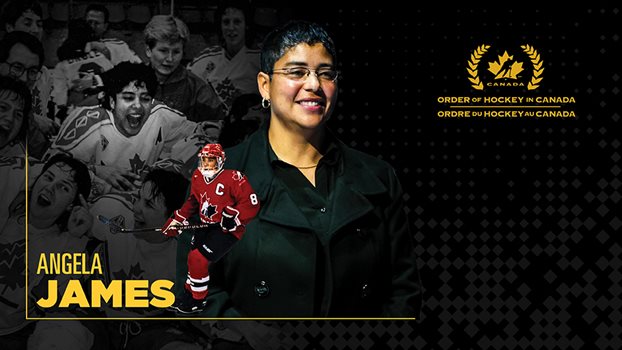
Changing the game
A dominant force as a player, Angela James set the standard for women’s hockey, and today she’s committed to ensuring others enjoy the opportunities the game can bring
Angela James is considered the first superstar of women’s hockey.
A member of Canada’s National Women’s Team from 1990 to 1999, she recorded 54 points in 50 international games and won four IIHF World Women’s Championship gold medals, twice earning a place on the media all-star team. In five games at the 1990 event, she scored 11 goals, still a tournament record.
She played in 12 Esso Women’s Nationals with Team Ontario, winning a medal every time, six of them gold. She was the top scorer for eight seasons – MVP for six – in the Central Ontario Women’s Hockey League, registering 241 points in 117 games. (The league evolved into the National Women’s Hockey League, the forerunner to the Canadian Women’s Hockey League, which named its top scorer trophy the Angela James Bowl.)
In her three years at Seneca College, she was a three-time scoring champion and three-time Most Valuable Player. Her last season, she scored 50 goals in 14 games playing defence.
She was one of the first women inducted into the IIHF Hall of Fame, in 2008, and the first Canadian woman inducted into the Hockey Hall of Fame, in 2010.
James started playing hockey simply to pass the time.
“I grew up in provincial housing, and there wasn’t a lot to do,” she says. “I loved hanging out with my friends. We played road hockey mostly and that evolved to an outdoor arena.” In the winter, she spent her free time at the outdoor rink. Occasionally, she’d have the ice to herself and use that ‘me’ time for skill development. Wherever she could get a ride, she would play.
A neighbour eventually suggested to James’ mom that she should get her daughter into organized hockey because she was so good.
“Up until that point, my mom just knew that I would say ‘bye’ and not come into the house until 10 at night because I would be out playing hockey,” says James. “Hockey was a huge part of my life. It was my life.”
James played her first season in a boys’ league when she was nine. She won the scoring title, and the next year girls were no longer allowed to play with the boys.
She dominated at every level she played.
“She was someone you wanted on your team,” says Fran Rider, president and CEO of the Ontario Women’s Hockey Association (OWHA) and a 2017 recipient of the Order of Hockey in Canada. “She was an incredible player that players on all teams respected. They admired her ability, her strength. She was a very strong, powerful player, and the skill level was absolutely amazing.
“She was an all-around player; she was a two-way player. She could play defence, forward, and she actually played one game in net and, of course, got a shutout. She changed the credibility of women’s hockey through her incredible ability.”
The profile of women’s hockey was raised considerably in 1990 with the first sanctioned world championship. James just wanted to play, but as the face of the game she had more eyes on her.
“She was the one the media was flocking to,” says Rider. “They wanted to see this ‘Gretzky of women's hockey.’ She didn't disappoint. She showed the incredible ability and she showed that women's hockey could stand alone, and it didn't need to be compared to anything.”
The game had incredible depth, says Rider, “it’s just that Angela was that good. She was that one step above, and it was above excellent players.
“She was a key factor in getting women’s hockey into the Olympics. A lot of people worked to get it there, but the key reason for our success was the quality of the players. Angela led the charge in that world tournament.”
James can’t pinpoint any singular highlight as a player; for her, it’s more the collective experience of being part of the game. Playing hockey afforded her the opportunity to go to different countries, meet new people and learn from different coaches. She relished the rivalries and competing. And, of course, she loved winning all those gold medals. But her proudest accomplishment isn’t a piece of hardware.
“I’m more proud of that era and those girls and what they've done now today,” she says. “The people that I played with in advancing the game, and hopefully being a small part of that, that's what I'm most proud of.”
It was important to put the game on the map.
“Back in 1990, our shirts were fluorescent, almost pink,” she says. “At the time, we would say we don't care if we have to wear polka-dots, we just want to play. We also knew that the young kids coming up would have something to aspire to later. And I think that’s happened.”
Words like trailblazer and pioneer often follow James. She accepts them, but doesn’t think she should be singled out.
“I always associate [those terms] with being old,” she says. “If that’s what they want to name it, that’s fine. I guess that’s what we were. I watched a lot of girls play hockey before me. Women have been playing for a long time and they’ve never really had the platforms that they do today, and hopefully one day we’ll get higher platforms. I’m just part of it, and I’m more than happy to be a part of it.”
James has continued to stay involved in women’s hockey off the ice. She received the Hockey Canada Female Breakthrough Award in 2005, which honours an individual who has made a significant contribution to the promotion and/or development of the game in Canada.
She’s officiated, coached and ran development programs. Once, at a masters tournament for the OWHA, teams were promised an alumna to play with. When some couldn’t make it, James played on every team as their role model. “She was laughing, but she was up for anything,” says Rider. “She knew how important it was for those women to have an opportunity to play hockey with her.”
“I coach house league, I coach rep, I coach wherever I’m needed,” says James. ”I just like being a part of the game. It doesn't really matter to me what level it is. You don't have to be playing pro to love our great game. If you can share what you know, at any level, you’ll get just as much out it."
James spent two years as part of the NHL & NHLPA Female Hockey Advisory Committee, an initiative aimed at growing women’s hockey in North America. She’s now working with the Hockey Diversity Alliance, offering a female perspective to their efforts to bring grassroots opportunities to the BIPOC community. And she’s part of a new Carnegie initiative that will develop educational toolkits and provide program opportunities that benefit the BIPOC community.
“She continues to inspire to this day,” says Rider. “She’s so deserving of the Order of Hockey in Canada. It's so good to see her awarded for the athlete and the person she is.”
The Order of Hockey in Canada recognizes individuals who have made outstanding contributions to the game of hockey.
“I find it a little surreal – to be given an honour for something that I love to doesn’t make sense to me,” says James. “It’s just a wonderful tribute to the women's game and my career and what I've done and what I love to do so. I’m honoured to be a recipient of the Order of Hockey in Canada.”
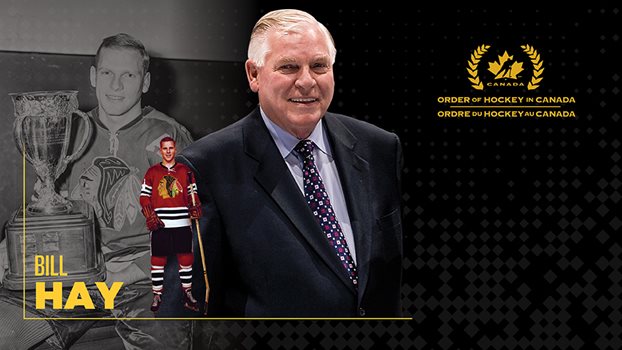
A man among men
It is safe to say no one has followed a career path in and out of the game quite like Bill Hay – from college to the NHL to the oil and gas industry to the Hockey Hall of Fame
Among the many skills Bill Hay possessed in his hockey career, it was his vision both on and off the ice that separated him from his contemporaries.
His peripheral view of hockey extended beyond a notable National Hockey League career and into the administrative direction of the game at the amateur level.
Through it all, the benefit to Canadian hockey is immeasurable, profound and perpetual.
From Major Junior and college to the NHL to providing direction and leadership in several different executive roles that enhanced the game, his résumé is rivaled by few.
It is this unique and distinguished history that earned him the honour of being named to the Order of Hockey in Canada along with Angela James and Kevin Lowe as the Class of 2021.
“He’s quite a guy,” says former Hockey Canada president and 2017 Order of Hockey in Canada honouree Murray Costello. “In my view, the [Order] was conceived for people like Bill Hay.”
Born in Saskatoon but raised in Regina, Hay has literally spent a lifetime in the game.
His playing career included two seasons with his hometown Regina Pats to a three-year stint in the NCAA with Colorado College, where he won a national championship in 1957.
His path to the Tigers pursuant to furthering his education and hockey career is fascinating, as he hitchhiked from Regina to Colorado Springs and walked on to the school’s hockey team, arriving with some clothes, little money and his equipment.
The 85-year-old looks back and describes that period of his life as “young and drifting.”
But it obviously served him well for the future. Aside from all-star and All-American accolades during his last two seasons and a national title, he graduated with a bachelor’s degree in geology and returned to Canada to start his professional career with the Calgary Stampeders of the Western Hockey League – a senior professional league – in 1958-59.
At the time his NHL rights were controlled by the Montreal Canadiens, but were sold to the Chicago Blackhawks for $25,000. Hay won the Calder Memorial Trophy as rookie of the year in 1959-60, the first of eight stellar NHL seasons.
His time in Chicago also came with a Stanley Cup championship in 1960-61, when he played on a line with Murray Balfour and Bobby Hull and fostered relationships with other teammates like Glenn Hall and Ab McDonald, along with creating a friendship with Gordie Howe.
And while most in Canada would presume the thrill of winning the Stanley Cup to be the prominent moment in a hockey career, that isn’t the case for Hay.
“Those awards are nice, but the highlight of my career was being the first NCAA college graduate to play in the NHL.
“And by being that, I think I establish a process that scouts would be looking at that league (for talent). I sort of set the precedent and others followed it.”
After retiring in 1967 after amassing 113 goals and 386 points in 506 games, Hay returned to Calgary and began a 25-year career in the oil and gas industry, running oil rigs around the world for Bow Valley Industries.
It was at this point the other side of his hockey career started as an administrator, a direction he wasn’t unfamiliar with – his father, Charles, was the first president of Hockey Canada in 1969 and notably helped negotiate the 1972 Summit Series between Canada and the Soviet Union.
While working for Daryl “Doc” Seaman at Bow Valley – one of the largest companies of its type in Canada at the time – Hay helped broker a meeting between Seaman and then NHL president John Ziegler to start the process of relocating the struggling Atlanta Flames to Calgary.
Seaman, along with others like Harley Hotchkiss, became part of a group of owners that financially facilitated the team’s move to Alberta in 1980. Hay later served as the team’s president and CEO from 1991 to 1995.
It was at the same time Hay became a member of the Hockey Hall of Fame selection committee, a duty he performed from 1980 to 1997. In fact, both he and his father are enshrined members of the esteemed Hall, a rare combination of father and son inductees.
Over the years Hay also contributed to the administrative side of the game as Hockey Canada president and chairman of the Hockey Hall of Fame board of directors, along with various other philanthropic initiatives to advance and improve the game in Canada.
“In comparison to most everyone else that I’ve dealt with over the years, he really has a feel for and a desire to make the game better in Canada for young players,” says Costello.
“He wanted to find a way to make our development system better. That was always top of mind in whatever Bill was working on.”
And despite what would appear to have been a busy and perhaps overwhelming period of volunteerism, Hay says it was more rewarding than laborious, especially with the support he received from his wife, Nancy, his three children and their families over the years.
“You really just go ahead and find time for it,” he says. “I learned a lot about hockey and the people that ran it. And one of the great things about hockey is how many great people there are in it.”
Through his work in the game, there is likely one other defining moment to Hay’s career and healthy list of contributions.
According to Costello, his influence and involvement in facilitating the merger in 1998 between the Canadian Amateur Hockey Association and Hockey Canada was instrumental in progressing the game. This aided hockey’s national development from the grassroots level to elite entities like the Program of Excellence.
“The merger would have never happened without Bill Hay,” says Costello. “He was an exemplary leader and was remarkable everywhere he went … and he always wanted to do something to make a difference in the game.”
Costello adds what Hay contributed over the decades to Canadian hockey is extraordinary and inimitable – an uncommon melding of two reputable careers in the game.
“Most people that make a contribution to our game do it either by leading by example by the way they played the game or they came back as a volunteer in the form of administrative leaders to improve programs along the way. Bill provided both.”
Looking back on his career, Hay says he’s “enjoyed every minute” and is gratified to know he made a difference in the development of the game throughout Canada, especially in educating and helping the development of young kids.
“I’m very humbled by it,” he says of the Order recognition. “This honour is as good an honour as I’ve received because it recognizes what I’ve done.”
To date, Hay is still involved with Hockey Canada, providing mentorship to many on the executive and prominently supporting of the Bill Hay Future Leaders internship program – an initiative he started only a few years ago.
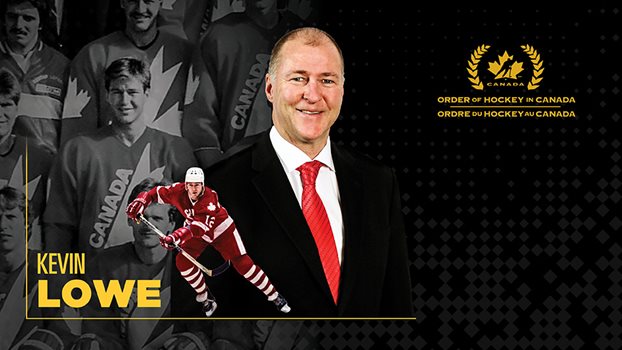
Treasured memories
Leadership and a personable demeanour helped elevate Kevin Lowe into management posts with Hockey Canada, and into a central role in memorable Canadian hockey moments
The impact of the 1972 Summit Series is immeasurable; in the memory of Kevin Lowe, it’s unforgettable.
The nation stood at a standstill for the eighth and deciding game of the culturally-charged series between Canada and the Soviet Union. Schools around the country forwent instruction that morning, and businesses had televisions tuned in so staff and customers alike could keep tabs on the all-important contest that would decide hockey supremacy.
A young Lowe watched on, engulfed in the moment along with all his schoolmates in Lachute, Que., and an estimated 15 million other Canadians as Paul Henderson scored arguably the most famous goal in the history of the game with 34 seconds left.
“I was 13 years old,” Lowe says. “I remember being in high school and classes were paused. They rolled the TV monitor in and the whole school watched the game.”
Ever since, he’s been driven to help create more of those ‘Paul Henderson’ moments. He’s found more than he would’ve ever imagined, and helped produce plenty more for Canadians everywhere.
“Just the way the series unfolded, it was a storybook finish. Seeing Canada win and the pride that came from seeing the whole country watching, it really planted the seed for me.”
Henderson’s goal still holds exalted status in Canadian hockey history nearly a half century later, and proved to be a major catalyst for Lowe to pursue a hockey career that would land him in the Hockey Hall of Fame as one of the best defensive defencemen in the NHL with six Stanley Cups, a King Clancy Memorial Trophy and 431 points in 1,254 games across 19 NHL seasons as a member of Edmonton Oilers and New York Rangers.
A year after receiving his call to the Hall as a player in the Class of 2020, his immense contributions to the game as an executive on the international stage will be celebrated with his naming to the Order of Hockey in Canada alongside fellow 2021 Distinguished Honourees Bill Hay and Angela James.
“The time I spent with Hockey Canada was an honour,” he says. “Thinking more recently about the time committed and the memories made, I feel an immense amount of pride.”
“Having said that, with the Hockey Hall of Fame, there was always a case that I was on the cusp of it for a lot of years. Although it took two decades, I was less surprised about that than I was about being named to the Order of Hockey in Canada.
“Never in my wildest dreams did I think that I would be [receiving it].”
Lowe recorded a goal and five assists in 16 international appearances for Team Canada, winning bronze at the 1982 IIHF World Championship and winning the 1984 Canada Cup to complement his storied NHL career.
When it came time to make the decision about life after retirement, Lowe could’ve pursued a post-playing career in media but elected to stay on the management side and return to Edmonton thanks to the influence of former Oilers general manager Glen Sather.
“After 10 years or so I knew I wanted to stay in hockey, whether it was directly involved with the team or indirectly on the media side,” Lowe says. “I’d written an article for the Edmonton Sun and did sports editorials on the radio in the mid ‘80s, so I had some inkling to do that. But my preference was always to be on the hockey side.”
“Glen was always thinking about the big picture, and we never had a conversation about [post-retirement] until it was time. I negotiated a contract to come back from New York for a year to play and two years to coach – a contract you couldn’t give today – and that was the seed that set me into the next wave of my career.”
Lowe served as an assistant coach for the Oilers in 1998-99 and head coach the following year before moving to the management side as general manager and executive vice-president of hockey operations in 2000.
Regardless of role, Lowe carried with him his desire to follow the path presented in front of him.
“I never aspired to be just a general manager,” he says. “I just aspired to be in the game, and it would take me wherever my abilities and performance did. It was others that invited me into those positions.”
Perhaps the biggest invite Lowe would receive was from a certain former teammate to join the management staff for the 2002 Olympic Winter Games.
“We took the step and announced Wayne [Gretzky] as the executive director, and the very first person he wanted to have on his staff, because he said he thought like him and loved his leadership, was Kevin Lowe,” says Bob Nicholson, the current Oilers CEO and vice-chair who served as president of Hockey Canada from 1998 to 2014. “Kevin was a slam dunk from that side. The two won all those Stanley Cups together and learned how to win together, so I thought that was really important.”
To be held in such high regard by his peers for his personable demeanour and leadership qualities was a powerful feeling to Lowe. “It was really heartfelt,” he says. “It was really touching, because it wasn’t like I was in on any conversations for this, and we hadn’t spoken in a long while. The question came out, and I said, ‘Wow, absolutely I’ll do that.’
“The more I thought about it, the more I felt touched by the fact that he thought enough of me that he would make that call.”
Canada ended a 50-year gold medal drought in Salt Lake City, and Lowe had a direct hand in providing Canadians with another foundational ‘Summit Series’ kind of victory – one that will be remembered for a lifetime.
“The Canadian fans singing the national anthem with a few minutes left in the game is something I’ll never forget,” Lowe says.
“Then the stories surfaced after the gold medal game of things like flights in Edmonton heading to Mexico, but the crew and passengers agreed to delay the flight so they could watch the game.”
Salt Lake City was only the start for Lowe, who won the World Cup of Hockey as assistant executive director two years later and joined Team Canada for a second Olympic experience in 2006.
He was also part of Canada’s management team at the 2010 Olympic Winter Games in Vancouver, handpicked by Steve Yzerman to help bring Canada a gold medal on home ice.
“[Yzerman] wanted to have one person from the Olympic gold medal team in 2002, and he chose Kevin Lowe,” Nicholson says. “It just shows you the kind of respect Kevin had, not just from Wayne, but from other players and great leaders such as Steve.”
“He’s the first NHL executive to be involved in three gold-medal winning Olympic teams, which is very unique in this country.”
With his extended experience as a player and a well-trusted acumen as an executive for Hockey Canada, Lowe lived in the moments presented to him and solidified himself as a worthy Order of Hockey in Canada honouree among the all-time greats.
“There’s too many people to thank, and the point is that’s one of the luxuries of being in one of those positions; new relationships and other hockey minds where you find the common bond is just trying to win a hockey game for Canada,” he says.
“When you’re working that closely with people, you develop a relationship that’s very strong.”

Driven by purpose
Sheldon Kennedy is a World Juniors gold medallist and Memorial Cup champion, but his legacy will be all he has accomplished off the ice to make the game a better place
A hockey player’s legacy is often measured in goals and assists, scoring titles, trophies and championships.
Sheldon Kennedy measures up just fine there. He won World Juniors gold with Canada in 1988, played at the event once more in 1989, and was named to the tournament all-star team at the ’89 Memorial Cup when he helped the Swift Current Broncos to the national championship. Kennedy also played more than 300 games in the National Hockey League with Detroit, Boston and Calgary.
But Kennedy’s real legacy goes far beyond what he did on the ice.
It’s measured in stats like 1.6 million, the number of people who have taken Respect in Sport and Respect in the Workplace online training. Or 70, the number of sport organizations in Canada that have made Respect training mandatory for all volunteers.
Kennedy’s legacy is perhaps best described by his long-time friend and business partner, Wayne McNeil.
“There would probably be no person that I know of in the sport of hockey who has used a bad situation to elevate education, awareness and accountability around some tough issues, but do it in a very positive way,” says McNeil. “He’s just done everything in such a positive way. He’s never come at this angry. He’s come at everything trying to make a positive difference.
“The cool thing is, yeah he played in the NHL, yes he won a Memorial Cup, and he won a gold medal at World Juniors, all of those great hockey accomplishments. But what he has accomplished in terms of the culture of the sport is phenomenal.”
Kennedy is part of the Class of 2020 of the Order of Hockey in Canada that will be honoured on June 14 during the Hockey Canada Foundation Virtual Gala. The accolade is the latest among the many tremendous accomplishments for the Elkhorn, Man., native, which also include being a Member of the Order of Canada and a recipient of the Alberta Order of Excellence.
Kennedy, with McNeil, founded the Respect Group in 2004 and, since then, the company’s e-learning modules have helped train millions of Canadians to recognize and prevent abuse, bullying, discrimination and harassment in sports, schools and workplaces.
“It’s a huge honour, both personally and for the issues that I represent,” says Kennedy, 51. “If I look at the history of Sheldon, of myself, in being involved in these issues from the time I told my story in 1996 to all the work that’s been done over the last 23 years … There was a time that I and the issues I represented weren’t in a position to receive any awards. Nor did people ever want to recognize Sheldon because of my history with struggles.
“When I look at an award like this, this represents hope and it gives people strength and hope that no matter where you’re at in your life, you can always reach those goals. This is what that represents to me. It’s both personal recognition but it’s also recognition for the issues that I represent, those kids and those people that have been hurt as kids. It shows how far we’ve been able to move the issue and raise the bar.”
It can sometimes be difficult to recall what the world was like over two decades ago. But when Kennedy shared his story of sexual abuse at the hands of his junior hockey coach Graham James in 1996, he wasn’t treated as a victim. At the time, James was among the most well-known junior coaches in the game and Kennedy’s rocky ride in the NHL was used against him. His struggles with drug and alcohol addiction were the focus of newspaper headlines and the story that many tried to spin then was a troubled hockey player making accusations against a renowned and respected coach.
“When I told my story and disclosed my story, there was a lot of questioning – people questioned me about my disclosure, they questioned me about what really happened, there was a lot of that,” he says. “Graham painted himself as being this great person, meanwhile Sheldon was this troublemaker. There was a lot I had to prove that this was not who I am and what was going on in my life was not who I was.”
Kennedy learned a lot during that time, including something that surprised him – that his story, while dark and tragic and difficult to discuss, wasn’t unique. He received thousands of letters from abuse victims from across the country and beyond. And that’s the time he turned his tragedy into opportunity to raise awareness and shine a spotlight on abuse.
In 1998, Kennedy raised $1.2 million in support of sexual abuse victims when he rollerbladed across Canada. It was a few years later that he and McNeil came up with the idea of an e-learning module to help those involved in sport recognize the signs of abuse, understand their roles and what they could do, and form a common language around the subject. To that point, all training on bullying and abuse had been done in person, in a classroom-type setting.
The Respect Group’s modules have grown and evolved over time and today you would be hard pressed to find someone involved in youth sport or education who hasn’t taken the training.
“For the last 23 years, it has been about shifting and changing and educating and teaching. Our whole mindset has been on the 98 per cent of people, the good people in not only the game of hockey but in all areas, to educate them in our communities to be better,” says Kennedy. “What we knew, and what I knew when I rollerbladed across this country, is that people didn’t know, they didn’t know what to do. And every incident that came before me, there were bystanders. So how do we create a confidence with those bystanders to be able to ask questions and come forward. That was our best defence.”
The work is far from done and, really, will never be done. Kennedy likes the analogy of a hockey team working on its power play. If that power-play unit hits 27 per cent effectiveness, and is maybe first in the league, you don’t stop working. You try to get to 30 per cent and beyond.
So, Kennedy and McNeil and their team keep going. There will always be challenges to overcome and people to help.
When Kennedy looks back on how he was able to commit his life to helping so many others, he says the work really began when he acknowledged the importance of his own health first.
“If I didn’t put myself and my own wellness as my number-one priority, none of the other things in my life would be where they’re at,” he says. “I’ve been able to have a healthy life; that means healthy relationships with my partner and daughter and son and my business colleagues. To me, that was something that I didn’t do at the start. I was out there just telling my story. That’s where we were at in the early days and trying to push for change. Meanwhile, I didn’t do the work on myself. Sometimes we forget how hard this work is and how important it is to make sure we’re taking care of ourselves. The healthier I am, the better I am at showing up for others, the better I can help and be prepared to do the best I can.”
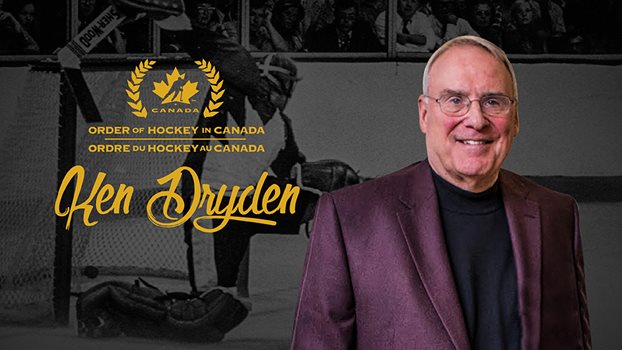
Ahead of his time
One of the greatest goaltenders of all time, Ken Dryden walked away from the NHL at just 31 to pursue his passions – as a lawyer, executive, educator, author and politician
Ken Dryden’s résumé speaks for itself.
He is a Hockey Hall of Famer, six-time Stanley Cup champion, five-time Vezina Trophy recipient, Calder Trophy winner and Conn Smythe Trophy winner, to name just a few accolades.
Despite playing just eight seasons in the National Hockey League, Dryden left a lasting mark on the game.
He began his pro hockey journey in 1970 as a wide-eyed rookie from Cornell University. After 33 games in the American Hockey League, Dryden got the call to join the Montreal Canadiens – a chance for the Islington, Ont., native to prove what he could do on the big stage.
He made just six appearances in the regular season before head coach Al McNeil made the decision to start the rookie in net against the Boston Bruins in the opening round of the playoffs. The Bruins, the defending Stanley Cup champions, had finished with the NHL’s best record and were heavy favourites.
Up against the likes of Bobby Orr and Phil Esposito, Dryden made a name for himself. He starred in the series to pull Montreal off one of the most memorable upsets in hockey history.
“When you’re playing, you’re just doing it,” Dryden explains when asked about the series. “You’re not making sense of any of it, you’re just playing. You’re faced with the next situation, and you’ve got to find a way of dealing with it.
“I never knew that I could do it, I just never knew that I couldn’t.”
Of course, Dryden went on to show that he could.
That season, he led the Habs past the Minnesota North Stars and Chicago Blackhawks to win the Stanley Cup, earning the Conn Smythe Trophy after posting a .914 save percentage in 20 playoff games.
“It didn’t take him long to make his mark,” former teammate Serge Savard says. “He came from nowhere and he was outstanding. What he achieved on the ice, nobody can match that up.”
For Dryden, the 1971 Cup triumph was just the beginning. He returned the following season and won Calder Trophy honours as rookie of the year, and earned the Vezina Trophy-Stanley Cup double with the Canadiens five times in seven seasons from 1972-79.
“It was just a team that really found itself and became something really special,” Dryden says of Montreal’s dynasty of the 1970s.
Of all his accomplishments on the ice, however, Dryden’s most meaningful didn’t come wearing the bleu, blanc and rouge. It was wearing the Maple Leaf during the 1972 Summit Series against the Soviet Union.
“That was beyond what any of us had experienced before,” he says. “You’d love to say that winning the series in 1972 was like winning the Cup, but your feelings tell you otherwise.
“It meant that much more to me than any of the others.”
Dryden got the call in Game 1 at the Montreal Forum, when the Soviets shocked an entire country with a 7-3 win. He took a second loss in Game 4 in Vancouver, but helped Canada stay alive with a 29-save performance in a 3-2 win in Game 6 in Moscow.
After Tony Esposito backstopped Canada to a series-tying win in Game 7, head coach Harry Sinden went back to Dryden for the deciding Game 8. With a nation captivated – an estimated 13.3 million Canadians watched the series finale – Dryden did his part with 22 stops in the 6-5 victory.
“Winning the last three games and Kenny being in net … it was special,” Savard says.
For all he did between the pipes, Dryden’s incredible legacy extends beyond his time on the ice. In 1979, during the prime of his career, Dryden decided to hang up his pads and begin a new adventure.
“I wanted to give myself some time and a chance to be good at something else,” Dryden says.
And just like he did against the Bruins in 1971, Dryden showed that he could.
He earned a law degree from McGill University.
He became a best-selling author, writing several books, including the critically acclaimed The Game – which is still highly regarded as one of the greatest hockey books of all time.
He moved into the front office, serving as president of the Toronto Maple Leafs from 1997 to 2003.
He became a politician, serving as a Member of Parliament for York Centre from 2004 to 2011. He was also appointed to Prime Minister Paul Martin’s federal cabinet as the minister of social development.
And he became a teacher, lecturing at the University of Toronto and his alma mater, McGill.
“I always think that the next thing, whatever it is, might be more interesting than the last,” Dryden says. “They might be more exciting and challenging.”
Savard described Dryden as “ahead of his time.”
He recalled his teammate carrying textbooks under his arm one day in the dressing room. “We were saying ‘Where’s this guy from?’ He was different than all of us, but he was a very, very dedicated person. He’s been an example.”
Like his time on the ice, Dryden pursued excellence in everything he set out to do. His dedication to his craft is a skill he attributes to his many years in hockey.
“I loved just getting immersed in playing and focusing on just that particular moment that the game forces you to do,” he says. “And in the doing it, you’re getting better and that immerses you even more. I certainly learned that or experienced it most deeply in sports.”
Even now, at 73 years old, the game still shapes several facets of Dryden’s life. Whether it’s his morning ritual of watching hockey highlights, the new novel he’s working on or livestreaming his grandsons’ hockey games. For Dryden, that’s what makes receiving the Order of Hockey in Canada all the more special.
While he’s been recognized with jersey retirements, several awards and plenty of hardware, this one’s different from the rest.
“The all-star team or trophies, they’re for specific moments and particular years. The Hockey Hall of Fame is about a stretch of time, it’s about those years in the NHL and it’s an acknowledgment of that,” Dryden explains. “What this award is about, it relates to a lifetime in hockey.”
“It’s minor hockey, it’s college hockey, it’s the national team and then it’s the Canadiens. It’s our kids and they play hockey, so it’s watching them play. Then our kids started having kids and so it’s watching our grandsons play and that’s right up to the present. This is an award that doesn’t have to do with a specific team, a specific time, a specific moment – it’s really a lifetime experience.”

The work never stops
Dr. Charles Tator is a staunch advocate for injury prevention in the game thanks to his work in spinal cord injuries and concussions
Dr. Charles Tator remembers winters in his childhood being so cold he could skate to school with his friends, and the janitors would build rinks in the playground for games before and after class. Hockey was a way of life for Dr. Tator in the 1940s and, like many his friends, he was a big fan of the Toronto Maple Leafs and enjoyed going to their games as a teenager. Though his seat was better than most.
By sheer luck, the Toronto native lived beside the Maple Leafs official photographer, and by the time Dr. Tator was in junior high school, Lou Turofsky would take him to games and use him as a ‘bulb boy.’
“So I carried a bag of bulbs and … he’d give me the hot old bulb he had just used and I’d put it in one part of the bag and give him a fresh one,” Dr. Tator says, adding there might be 100 or more photos taken in a single game – with a fresh bulb needed for each shot.
“Imagine meeting Syl Apps, Ted Lindsay, people of that caliber and having your picture taken with them!”
It was a dream childhood for a hockey fan, playing on true outdoor rinks and meeting your idols. But for Dr. Tator, one of his most recent realizations of that time is he can’t remember more than one serious injury from playing. And the one he does, was a friend missing a slap shot, losing his balance and breaking his arm.
“The most amazing thing, in all my years of playing hockey … nobody ever got hurt. But yet when I started my practice, I treated several players who broke their necks playing hockey,” he recalls. “It was so horrible for me to have to look after young people who were playing the sport they loved, playing the sport I loved, actually ending up in wheelchairs.”
Dr. Tator graduated from the Faculty of Medicine at the University of Toronto in 1961 and four years later had his master’s degree and PhD. In 1969, he became a Fellow of the Royal College of Physicians and Surgeons of Canada, the beginning of an illustrious career specializing in spinal cord injuries. While he knew he’d be seeing patients with serious injury in his practice, he never imagined those would be children playing hockey.
“When I saw how many kids were ending up in wheelchairs I decided, as they say, to go up stream and see what was doing this,” he says.
His research would lead to one simple conclusion – checking from behind was the main cause of broken necks in hockey. It was a finding that would drastically alter the way the game was played with the introduction of new penalties.
“The medical community is one of the most important partnerships we have in keeping the players safe and healthy and (Dr. Tator’s) impact on hockey is felt every time somebody steps on the ice,” says Fran Rider, 2017 Order of Hockey in Canada recipient. She believes Dr. Tator has saved hundreds of lives and preserved the quality of life for countless more, having witnessed the reduction of severe injuries firsthand as the president and CEO of the Ontario Women’s Hockey Association.
“Once we identified you could break your neck if you got pushed into the boards from behind, it led to Hockey Canada developing a specific rule against checking from behind,” Dr. Tator explains, adding there was immediate buy-in at the national level, but spreading the word to grassroots players would prove to be more challenging.
Needing a bigger platform to share his findings, Dr. Tator established an injury prevention program called Smart Hockey, which would become part of Parachute Canada. He has a seat on the board of directors to this day. He also founded ThinkFirst Canada in 1992, another group with a mission of injury prevention. For those involved with minor hockey, the ‘STOP’ signs on the back of all jerseys is a legacy of Dr. Tator’s educational work.
But the work didn’t stop there. Another serious injury was emerging in contact sports and Dr. Tator quickly became involved in concussion research, identifying how athletes get concussions and how to recover from them. Though he says the real challenge is the work of prevention.
“As a neurosurgeon, I have seen the difficulties of putting the pieces back together again after the event,” Dr. Tator explains. “So, we [need do to more to enforce] the rules, because in some cases the pieces are so far apart you can’t put them back together again and patients are left with significant disability.”
Although nearly 85 years old, Dr. Tator doesn’t believe his work is done. He continues to advocate for country-wide concussion legislation, similar to Rowan’s Law in Ontario, and believes hockey would be a safer game with the complete elimination of fighting.
“Yes, I am happy with what’s been done but we should be able to do more, and I think that concussion legislation is something that will move injury prevention higher on the agenda of what is important to kids, coaches and parents,” he says.
Rider recognizes change can be difficult but believes in the injury prevention message of Dr. Tator as he looks to improve the lives of individuals and the whole hockey-loving community.
“It was so inspiring to work with him at the top of his field in the medical profession and also that he was such a kind and caring person that he truly wanted to help each individual,” Rider says of Dr. Tator’s work. A sentiment echoed by the good doctor himself.
“I would like to save the game so that other kids can enjoy it as much as I enjoyed it … and by Hockey Canada recognizing me, I think it’s part of saving the game.”
For more information: |
- <
- >
















